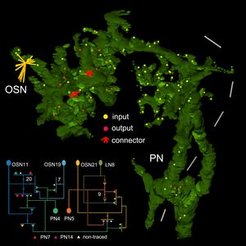
Neural circuits in the olfactory system of arthropods
The neural basis of olfaction is studied from a morphological and evolutionary perspective. We are examining the olfactory systems of Drosphilids, and small coeleopterans. Our key techniques are confocal microscopy, neural tracer and as well as electron microscopy (Cryo-FIB-SEM, SEM, TEM) to analyze the neural circuitry involved in olfaction in the arthropod brain.

Cellular Networks
The antennal lobe neural network is analyzed using correlative light- and electron microscopy to determine the connectivity of sensory, local and output neurons (OSN, LN, PN) in and across glomeruli (Rybak, Talarico et.al; 2016 supplementary). Using genetic tools (GAL4/UAS, LexA/LexAop) we identify cells using GRASP (Reconstitution Across Synaptic Partners). Employing Laser-Branding and Photoconversion in combination with electron dense markers (DAB) we are aiming to eludicate the synaptic microcircuits of specific glomeruli at the ultrastructural level.
Computational Neuroanatomy
In order to generate realistic models of brain structure, and identify structures across modalities, morphometric measures using digital reconstruction and image registration techniques are applied.
Evolution
Insect occupy a diversity of ecological niches, and thereby, often reducing body size to an extreme. How this reduction does determine the architecture of the nervous system? By focusing on the olfactory system we investigate the effects of brain miniaturization in the specialized group of Ptiliidae (Featherwing beetles).
Cooperations/grants
DFG SPP 2205 Evolutionary optimization of neuronal processing (https://www.uni-goettingen.de/en/mission/618330.html)
